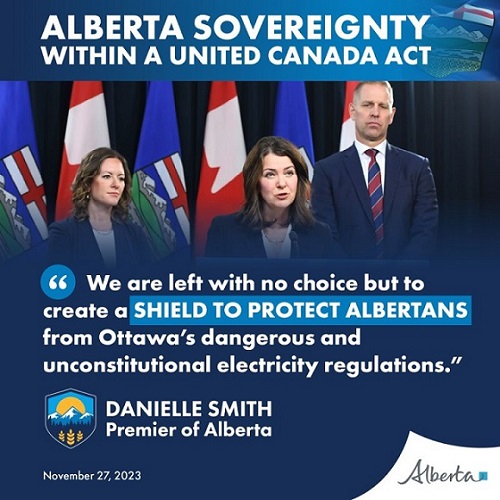Alberta
Premier Smith introduces Alberta Sovereignty Act to battle Ottawa in net-zero battle

“We are left with no choice but to create a shield to protect Albertans from Ottawa’s dangerous and unconstitutional electricity regulations”
Defending Alberta from brownouts, blackouts and soaring costs
Premier Danielle Smith has introduced an Alberta Sovereignty Within a United Canada Act resolution to protect Alberta from the federal government’s proposed net-zero electricity grid regulations to ensure Albertans have access to reliable and affordable power when and where they need it.
Alberta’s government will not put Albertans and their businesses at risk of freezing in the dark at -30 C due to the federal government’s proposed unaffordable, unreliable and unconstitutional Clean Electricity Regulations (CERs).
The federal government has been clear it is unwilling to align its electricity regulations with Alberta’s Emissions Reduction and Energy Development Plan as the province works to achieve carbon neutrality by 2050. Instead, the federal government has continued to indicate it will move ahead with its plan to implement unrealistic requirements for a net-zero electricity grid by 2035, regardless of the costs and risks to Albertans.
To protect Albertans from future brownouts, blackouts and soaring costs, Alberta’s government has introduced the first Alberta Sovereignty within a United Canada Act resolution. This resolution asks the legislative assembly of Alberta for approval to take strong, effective action over the coming months and years to counteract the harms and risks to Albertans posed by the federal CERs.
“We have tried to work with Ottawa to align their emissions-reduction efforts with our provincial plan to achieve a carbon-neutral power grid by 2050. Unfortunately, after months of meetings, they continue to reject this opportunity and remain committed to an absurdly unrealistic and unattainable goal of a net-zero power grid by 2035. We are left with no choice but to create a shield to protect Albertans from Ottawa’s dangerous and unconstitutional electricity regulations. They may be willing to expose Albertans to high costs, blackouts and brownouts, but we are not, and we will continue to ensure Albertans are protected from these destructive and unconstitutional federal policies.”
The CERs propose unrealistic rules with Criminal Code violations to achieve net-zero electricity by 2035. Alberta’s grid needs more baseload power from natural gas, but these regulations have created uncertainty and are driving away investment. This threatens the reliability and economic well-being of Alberta’s homes and businesses.
Alberta does not have enough applications for new natural gas power plants to provide the substantial new generation of power the province needs, primarily due to the investor uncertainty caused by the federal government’s extreme policies.
“The courts are on our side, science and logic are on our side, the Constitution is on our side – electricity generation is the jurisdiction of the provinces, not the federal government. It is our responsibility to provide safe, reliable and affordable electricity to all Albertans without interference from Ottawa. This is what we are doing and will continue to do.”
“The federal regulations will hurt grid reliability for families and businesses while sending costs soaring. Everything we have seen from Ottawa suggests they simply don’t care how these rules will hurt Albertans. We will not put families at risk of rationing power during the coldest days of the year.”
If passed, the Alberta Sovereignty Within a United Canada Act resolution will help protect Alberta’s electricity grid and ensure that homes and businesses across the province can access reliable, affordable power for decades to come.
The resolution asks Alberta’s cabinet to order all provincial entities not to recognize the constitutional validity of, enforce, nor cooperate in the implementation of the CERs in any manner, to the extent legally permissible. This order would not apply to private companies or individuals. The resolution also asks Alberta’s government to work with the Alberta Electric System Operator, Alberta Utilities Commission and others to implement various reforms to Alberta’s electrical system to ensure grid affordability and reliability.
In addition, the resolution instructs the government to work with industry, regulators and other groups to study the feasibility of establishing a provincial Crown corporation for the purpose of bringing and maintaining more reliable and affordable electricity onto the grid in the event that private generators find it too risky to do so under the CERs.
This Alberta Crown corporation would be a provincial entity and would not recognize the CERs as constitutionally valid. If needed, the Crown corporation would work with industry and other stakeholders to bring on needed electricity onto the grid, either through building new generation or purchasing existing generation assets (i.e. natural gas power plants) that private industry would otherwise not build or shut down due to the uncertainty and penalties established by the CERs. It could also be used as a means of assisting and partnering with industry to de-risk investments in nuclear power and other emerging green generation if needed.
Alberta must be prepared should the CERs lead to divestment in natural gas generation and power plants being turned off in 2035. This initiative would be an important first step towards protecting Albertans’ continued access to reliable and affordable electricity should this occur.
The resolution also urges the government to use all legal means necessary to oppose the federal electricity regulation, including legal challenges.
Quick facts
- According to the Constitution of Canada, legislating and regulating the development of electricity explicitly falls within the jurisdiction of the province (Section 92A (1) (c)).
- Alberta has reduced electricity emissions by 53 per cent since 2005.
- Analysis by the Alberta Electric System Operator determined that Alberta would face disproportionate risk and costs, compared with other provinces, as a result of the federal electricity regulations.
- Alberta’s grid had seven alerts during colder months in 2022 and had three alerts in summer 2023, underscoring the importance of having sufficient stable baseload power sources like gas, hydro and nuclear available year-round. Alberta must continue to rely on a diverse mix of intermittent and baseload options to prevent future brownouts and blackouts and maintain a reliable grid.
- The Public Policy Forum previously indicated that the cost of the federal electricity approach could be more than $1 trillion and as high as $1.7 trillion.
Related information
Alberta
Alberta school boards required to meet new standards for school library materials with regard to sexual content

Alberta’s government has introduced new standards to ensure school library materials are age-appropriate.
School libraries should be safe and supportive places where students can learn and explore without being exposed to inappropriate sexual content. However, in the absence of a consistent standard for selecting age-appropriate library materials, school boards have taken different approaches, leading to concerns about safeguards in place.
In response to these concerns, and informed by feedback from education partners and the public, Alberta’s government has created standards to provide school boards with clear direction on the selection, availability and access to school library materials, such as books.
“Our actions to ensure that materials in school libraries don’t expose children to sexual content were never about banning books. These new standards are to ensure that school boards have clear guidance to ensure age-appropriate access to school library materials, while reflecting the values and priorities of Albertans.”
The new standards set clear expectations for school library materials with regard to sexual content and require school boards to implement policies to support these standards.
Standards for school library materials
Under the new standards, school libraries are not permitted to include library materials containing explicit sexual content. Non-explicit sexual content may be accessible to students in Grade 10 and above, provided it is age-appropriate.
“Protecting kids from explicit content is common sense. LGBTQ youth, like all children, deserve to see themselves in stories that are age-appropriate, supportive and affirming – not in material that sexualizes or confuses them.”
School boards must also regularly review their school library collections, publish a full list of available materials and ensure that a staff member supervises students’ access to school library materials. School boards will have to remove any materials with explicit sexual content from their school libraries by October 1.
School board policies and procedures
All school boards must have publicly available policies that align with the new standards for selecting and managing library materials by January 1, 2026. School boards can either create new policies or update existing ones to meet these requirements.
These policies must outline how school library materials are selected and reviewed, how staff supervise students’ access throughout the school day, and how a student, parent, school board employee or other member of the school community can request a review or removal of materials in the school library. School boards are also required to clearly communicate these policies to employees, students and parents before January 2026.
“A robust, grade- and age-appropriate library catalogue is vital for student success. We welcome the ministry’s initiative to establish consistent standards and appreciate the ongoing consultation to help craft a plan that will serve our families and communities well.”
“Red Deer Public Schools welcomes the new provincial standards for school library materials. Our division is committed to maintaining welcoming, respectful learning spaces where students can grow and thrive. Under the new standards for school libraries, we remain dedicated to providing learning resources that reflect our values and support student success.”
Quick facts
- The new standards will apply to public, separate, francophone, charter and independent schools.
- The ministerial order does not apply to municipal libraries located within schools or materials selected for use by teachers as learning and teaching resources.
- From May 26 to June 6, almost 80,000 people completed an online survey to provide feedback on the creation of consistent standards to ensure the age-appropriateness of materials available to students in school libraries.
Related information
- Ministerial Order
- School library standards engagement
- Reference Materials: Content warning: this document contains graphic content that may be disturbing to viewers and is not appropriate for young viewers. Viewer discretion is advised.
Alberta
Fourteen regional advisory councils will shape health care planning and delivery in Alberta

Regional health councils give Albertans a voice
Albertans want a health care system that reflects where they live and adapts to the unique needs of their communities. As part of the province’s health care refocus, Alberta’s government committed to strengthening community voices by providing more opportunities for Albertans to bring forward their local priorities and offer input on how to improve the system.
The regional advisory councils, made up of 150 members from 71 communities, will advise Alberta’s four health ministries and the newly refocused health agencies: Primary Care Alberta, Acute Care Alberta, Assisted Living Alberta and Recovery Alberta. Each council will explore solutions to local challenges and identify opportunities for the health system to better support community decision-making.
“By hearing first-hand community feedback directly, we can build a system that is more responsive, more inclusive and ultimately more effective for everyone. I am looking forward to hearing the councils’ insights, perspectives and solutions to improve health care in all corners of our province.”
“Regional advisory councils will strengthen acute care by giving communities a direct voice. Their insights will help us address local needs, improve patient outcomes and ensure timely access to hospital services.”
“A ‘one-size-fits-all’ approach does not address unique regional needs when it comes to mental health and addiction challenges. These councils will help us hear directly from communities, allowing us to tailor supports and services to meet the needs of Albertans where they are.”
“Every community has unique needs, especially when it comes to seniors and vulnerable populations. These regional advisory councils will help us better understand those needs and ensure that assisted living services are shaped by the people who rely on them.”
Members include Albertans from all walks of life, health care workers, community leaders, Indigenous and municipal representatives, and others with a strong tie to their region. About one-third of members work in health care, and more than half of the council chairs are health professionals. Almost one-quarter are elected municipal officials, including 10 serving as chairs or vice-chairs. Ten councils also include a representative from a local health foundation.
Council members will share local and regional perspectives on health care services, planning and priorities to help ensure decisions reflect the realities of their communities. By engaging with residents, providers and organizations, they will gather feedback, identify challenges and bring forward ideas that may not otherwise reach government.
Through collaboration and community-informed solutions, members will help make the health system more responsive, accessible and better able to meet the needs of Albertans across the province.
“As Primary Care Alberta works to improve access to primary health care services and programs across Alberta, we are grateful to have the opportunity to tap into a dedicated group of community leaders and representatives. These people know their communities and local needs, and we look forward to learning from their experiences and knowledge as we shape the future of primary care in Alberta.”
“The regional advisory councils will help to bring forward the voices of patients, families and front-line providers from every corner of Alberta. Their insights will help us plan smarter and deliver care that’s timely, effective and truly local. We look forward to working closely with them to strengthen hospital and surgical services across the province.”
“Nobody understands the health care challenges unique to a community better than the people who live there. The regional health advisory councils are made up of those living and working on the front lines across the province, ensuring we are getting the perspective of Albertans most affected by our health care system.”
“Alongside Recovery Alberta’s staff and physician team, these regional advisory councils will build upon the high standard of mental health, addiction and correctional health services delivered in Alberta.”
Indigenous Advisory Council
Alberta’s government continues to work directly with Indigenous leaders across the province to establish the Indigenous Advisory Council to strengthen health care services for First Nation, Métis and Inuit communities.
With up to 22 members, including Indigenous health care workers, community leaders and individuals receiving health care services, the council will represent diverse perspectives across Alberta. Members will provide community perspectives about clinical service planning, capital projects, workforce development and cultural integration in health care.
Related information
-

 Bruce Dowbiggin2 days ago
Bruce Dowbiggin2 days agoThe Covid 19 Disaster: When Do We Get The Apologies?
-

 Crime1 day ago
Crime1 day agoSweeping Boston Indictment Points to Vast Chinese Narco-Smuggling and Illegal Alien Labor Plot via Mexican Border
-

 Alberta1 day ago
Alberta1 day agoAlberta school boards required to meet new standards for school library materials with regard to sexual content
-

 Business14 hours ago
Business14 hours agoTrump slaps Brazil with tariffs over social media censorship
-

 Environment1 day ago
Environment1 day agoEPA releases report on chemtrails, climate manipulation
-

 International15 hours ago
International15 hours agoSupport for the Ukraine war continues because no one elected is actually in charge.
-

 Addictions17 hours ago
Addictions17 hours agoCan addiction be predicted—and prevented?
-

 Business18 hours ago
Business18 hours agoCBC six-figure salaries soar



